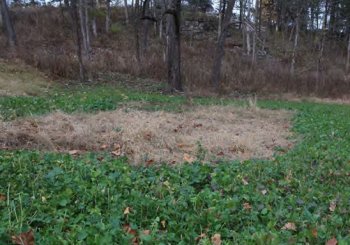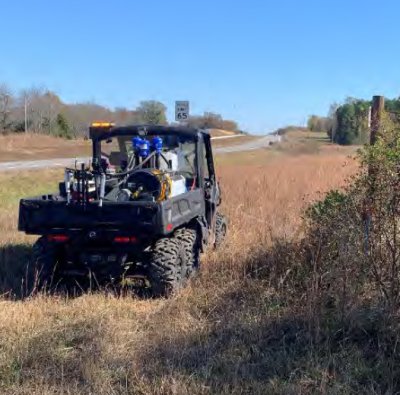AgEBB-MU CAFNR Extension
Green Horizons
Volume 25, Number 1
Winter 2021
Good News for 2020: Individuals and Groups
Recognized for Invasive Plant Action in Missouri
Tina Casagrand
 |
Hillside where honeysuckle was covering the rock faces, which are in the background. Bryan used a hack and |
As public awareness grows about the harmful effects of invasive plants, the Missouri Invasive Plant Task Force (MoIP) recognized two individuals and one group in Missouri who have exhibited outstanding work controlling invasive plants on property across the state. These Action Awards seek to demonstrate how controlling the spread of invasive plants on Missouri farms, forests, woodlands, prairies, gardens, roadsides and along waterways is wise stewardship. A recommendation by a natural resource professional is required to be eligible. Members of MoIP evaluate nominations. "There are many individuals and groups carrying out impressive invasive plant control in every corner of the state," says Carol Davit, chair of MoIP and executive director of the Missouri Prairie Foundation. "We want to recognize those doing exemplary work and present them with an award at an event of the awardee's choice to be honored in front of their peers."
2020 Invasive Plant Action Award for Individual Citizen: Jason Bryan
MoIP members chose Boone County landowner Jason Bryan as the recipient of the Individual Citizen award. "Like most landowners I deal with, Jason was interested in managing his property for better wildlife habitat to increase deer and turkey use, but most importantly he wanted to leave the property in better shape that it currently was," Missouri Department of Conservation (MDC) Private Land Conservationist Ryan Lueckenhoff wrote in his nomination. He noted that multiflora rose (Rosa multiflora), wintercreeper (Euonymus fortunei `Coloratus') and bush honeysuckle (Lonicera maackii and Lonicera x bella) were common through the wooded areas on the property, and they were getting worse. On one rocky outcrop, Lueckenhoff says, "Bush honeysuckle was so thick that you could not see from the top of the hillside through to the bottom and little to no wildlife were using the area." He worked with Bryan to develop a 10-year plan for the property, with invasive species removal at the top of the list. The Bryan family started removing invasive plants the first year and have seen incredible success, with new visibility and returned wildlife.
Members of MoIP have gathered resources, tools, and guides that help landowners understand, assess, and manage invasive and exotic plants commonly found in Missouri, including those found on Bryan's property. Lueckenhoff added that Bryan understands the importance of follow-up treatments. "His commitment to this removal effort has been awesome to see!"
2020 Invasive Plant Action Award for Individual Professional: Roger Frazier
MoIP is proud to present MDC Priority Habitat Coordinator Roger Frazier with the Individual Professional award. "Roger Frazier has a long history of supporting Conservation for all the right reasons," writes MDC private land services chief Jason Jensen in his nomination. "For him, it is not just a job, and not even just a profession; it is his passion and his lifelong commitment to protect, conserve, and serve Missouri's Natural Heritage. But putting all that aside, we are nominating him for this award because of his recent efforts that have gone way beyond even what the most demanding of us would call above and beyond." Adam Frazier has an extensive list of invasive plant success stories including developing the Southwest Missouri Region Invasive Species Strike Team who worked tirelessly to prevent the spread of invasive plant and protect Conservation Opportunity Areas. Frazier is also recognized for serving as a member of MDC's Invasive Species Coordination Team, helping to start and secure funding for the Scenic Rivers Invasive Species Partnership, and working with the City of Farmington and AmeriCorps on the Engler Park Eradication project.
Furthermore, Frazier's duties as Priority Habitat Coordinator have kept him continually engaged with both MDC and Natural Resources Conservation Service staff on invasive species management on private land. "For those of us that work alongside Roger, even these words do not fully express the level of commitment and contribution Roger has made towards true invasive species management in Missouri," Jensen writes.
 |
Spearheading the development of the Southeast Missouri Region Invasive Species Strike Team is just one of |
2020 Invasive Plant Action Award for Group Collaboration:
Jason Jensen, Jan Dellamano, Roger Frazier, Chris Rutledge, Mark Auffenberg, and Tony Jaco
This group collaboration started in 2007 as a grassroots effort led by Jan Dellamano and the local MoDOT shed. Over the years, it has transformed into a long-term commitment to address the growing problem of invasive plant spread on highway rights-of-ways (ROW). This effort has been effective in stopping the spread of extremely invasive plants such as spotted knapweed (Centaurea stoebe L. subsp. micranthos) and teasel (Dipsacus fullonum L. and D. laciniatus).
 |
Two state agencies and a nonprofit organization are engaged |
This project has had many facets including conceptualizing, planning, gaining and developing administrative and budgetary support, equipment, and implementation on the ground. All of this occurred with the cooperation of two state agencies (MDC and MoDOT), and a nonprofit organization, the Missouri Prairie Foundation (MPF). (MPF is excluded from the award, due to the nature of MoIP's being housed under MPF's Grow Native! program).
"I drive I-55 between Cape Girardeau to St. Louis with regularity, and I can see a clear difference between areas impacted by this arrangement and those that have no such treatment," writes Tony Jaco, Southeast Regional Administrator for MDC, in his nomination. "I have witnessed a decline of teasel, sericia lespedeza, autumn olive, and spotted knapweed. This impacts the area treated with herbicides specifically, but it has a larger reach as the mowing equipment used by MODOT will not have carry as much seed debris from invasives which leads to spread of the invasives. It also benefits the watersheds I-55 touches because seed stock will not be flowing down stream to infect new properties."
This pilot program has caught on and is being considered and/ or replicated in other parts of the state.
The Missouri Invasive Plant Task Force (MoIP) is a resource of Grow Native!-a 19-year-old native plant marketing and education program serving the lower Midwest. Grow Native! is administratively housed by the nonprofit Missouri Prairie Foundation. For more information about MoIP, visit www.moinvasives.org, email info@moinvasives.org or call 417-299-1794; for more on the Grow Native! program at grownative.org or for more on the Missouri Prairie Foundation visit moprairie.org.
Reminder: By definition, invasive plants are those not native to a region whose abundance and/or rapid spread that harms economic and environmentally important resources.
